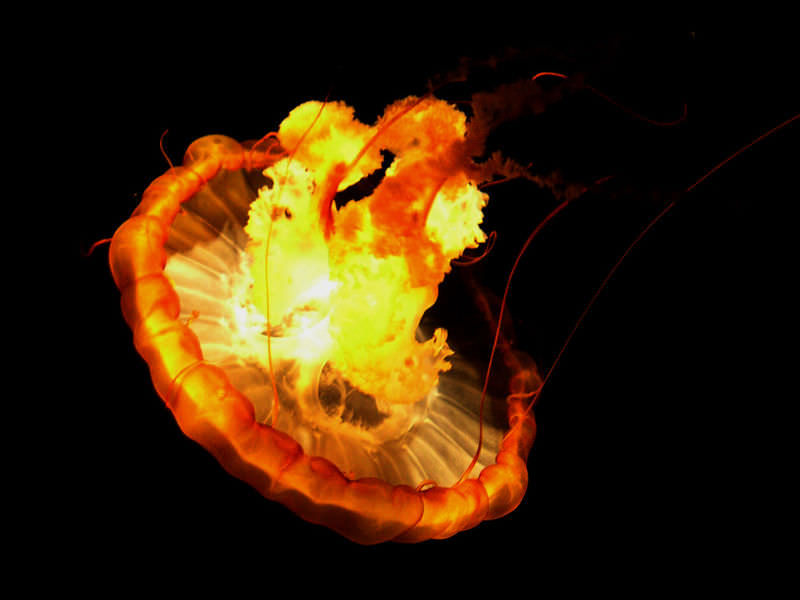可见光光源
章节大纲
-
Imagine scuba diving and coming upon a jellyfish. Would you be startled if the jellyfish suddenly started to glow with bright yellow light, like the jellyfish in the picture above? If so, then the jellyfish would have done its job. Jellyfish give off light to startle possible predators. The light they emit is visible light .
::想象一下潜水和水母。 如果水母突然开始以亮黄色的光照发光, 就像上面的图片中的水母那样? 如果是这样,水母就会完成它的工作。 水母会给可能捕食的捕食者点亮光。 它们发出的光是可见的光。The Light We See
::我们所见的光明Visible light includes all the of light that the human eye can detect. It allows us to see objects in the world around us. Without visible light, we would only be able to sense most objects by sound, touch, or smell. Like humans, most other organisms also depend on visible light, either directly or indirectly. Many animals—including predators of jellyfish—use visible light to see. Plants and certain other organisms use visible light to make food in the process of . Without this food, most other organisms would not be able to survive.
::可见光包括人类眼睛能够探测到的所有光,它使我们能够看到我们周围的世界中的物体。没有可见光,我们只能通过声音、触摸或嗅觉来感知大多数物体。与人类一样,大多数其他生物也直接或间接地依赖可见光。许多动物,包括水母捕食者,利用可见光来观察。植物和某些其他生物利用可见光来制造食物。没有这种食物,大多数其它生物将无法生存。Q: Do you think that some animals might be able to see light that isn’t visible to humans?
::问:你认为有些动物可能能看到人类看不到的光线吗?A: Some animals can see light in the infrared or ultraviolet range of wavelengths. For example, mosquitoes can see infrared light , which is emitted by warm objects. By seeing infrared light, mosquitoes can tell where the warmest, blood-rich areas of the body are located.
::A:有些动物可以在波长的红外线或紫外线范围内看到光。例如,蚊子可以看到由温暖物体释放的红外线光。通过看到红外线光,蚊子可以知道身体最温暖、血液丰富的区域的位置。Incandescence
::白炽光Most of the visible light on Earth comes from the sun. The sun and other stars produce light because they are so hot. They glow with light due to their extremely high temperatures. This way of producing light is called incandescence . Incandescent light bulbs also produce light in this way. When electric current passes through a wire filament inside an incandescent bulb, the wire gets so hot that it glows. Do you see the glowing filament inside the incandescent light bulb in the Figure ?
::地球上大部分可见的光来自太阳,太阳和其他恒星的光亮是热的,它们以光亮发光,因为它们的温度极高。这种光光的产生方式被称为不清洁。白昼灯泡也以这种方式产生光亮。当电流在白昼灯泡内穿透丝丝丝时,电线变得如此热,以至于发光。你看到图中白昼灯泡内发光的丝质吗?Q: What are some other sources of incandescent light?
::问题:什么是白昼光的其他来源?A: Flames also produce incandescent light. For example, burning candles, oil lamps, and bonfires produce light in this way.
::A:火焰还产生白光,例如燃烧蜡烛、油灯和营火,以这种方式发光。Luminescence
::冷光Some objects produce light without becoming very hot. They generate light through or other processes. Producing light without is called luminescence . Luminescence, in turn, can occur in several different ways:
::有些物体产生光,但不会变得非常热。 它们通过其他过程或其它过程产生光。 没有光的产生光被称为发光。 光的产生可以以几种不同的方式发生:-
One type of luminescence is called fluorescence. In this process, a substance absorbs shorter-wavelength
ultraviolet light
and then gives off light in the visible range of wavelengths. Certain minerals produce light in this way, including gemstones such as amethyst, diamond, and emerald.
::一种发光类型被称为荧光。 在这一过程中,一种物质吸收了较短波长的紫外线光,然后在可见的波长范围内释放光亮。 某些矿物以这种方式产生光亮,包括复合石、钻石和绿宝石等宝石。 -
Another type of luminescence is called electroluminescence. In this process, a substance gives off light when an electric current passes through it.
such as neon, argon, and krypton produce light by this means. The car dash lights in the
Figure
are produced by electroluminescence.
::另一种发光类型被称为电光。 在这一过程中,当电流通过电流时,物质会发出光亮,例如用这种方式产生光亮。图中的汽车破碎灯是用电光生成的。
-
A third type of luminescence is called bioluminescence. This is the production of light by living things as a result of chemical reactions. The jellyfish in the opening photo above produces light by bioluminescence. So does the firefly in the
Figure
. Fireflies give off visible light to attract mates.
::第三种发光类型被称为生物发光。 这是通过化学反应产生的生物光。 上面的开张照片中的水母通过生物发光产生光。 图中的萤火虫也通过生物发光产生光。 萤火虫提供可见的光来吸引伴侣。
Watch the video below to learn more about undersea creatures that make light:
::观看下面的录像, 以了解更多有关海底生物的光线:Illumination
::照明Many other objects appear to produce their own light, but they actually just reflect light from another source. Being lit by another source is called illumination . The moon in the Figure is glowing so brightly that you can see shadows under the trees. It appears to glow from its own light, but it’s really just illuminated by light from the sun. Everything you can see that doesn’t produce its own light is illuminated by light from some other source.
::许多其他物体似乎都有自己的光线,但它们实际上只是从另一个来源反射光线。 被另一个来源点燃的光线被称为光照亮。 图中的月亮亮光照亮,你可以看到树下的阴影。 它似乎从自己的光线中发光,但太阳的光线照亮了它。 你看到的无法产生自己光线的一切,都是从其他来源的光线照亮的。Summary
::摘要-
Visible light includes all the wavelengths of light that the human eye can detect. Humans and virtually all other organisms depend on visible light to survive. Humans and many other animals use it to see. Plants use it to make food for themselves and most other organisms.
::可见光包括人类眼睛能够探测到的所有波长光。人类和几乎所有其它生物依靠可见光生存。人类和许多其他动物用它来观察。植物用它为自己和大多数其它生物做食物。 -
Most of the visible light on Earth comes from the sun. The sun produces light because it is so hot. Glowing with visible light because of a high temperature is called incandescence.
::地球上大部分可见的光来自太阳,太阳产生光,因为它太热。高温带来的可见光耀眼被称为不耐烦。 -
Producing light without a high temperature is called luminescence. Types of luminescence include fluorescence, electroluminescence, and bioluminescence.
::没有高温的制导光被称为发光,发光的类型包括荧光、电光和生物发光。 -
All objects you can see that do not produce their own light are reflecting light from another source. This is known as illumination.
::所有您可以看到的未生成自己光线的物体都从其它来源反映了光。 这被称为照明 。
Review
::回顾-
What is visible light?
::什么是可见光? -
Define incandescence, and give an example of an incandescent light source.
::定义天性, 并举一个白白光源的例子 。 -
What is luminescence?
::什么是发光? -
Make a table comparing and contrasting three ways that luminescence can occur.
::制作一张表格,比较和对比三种发光方式。 -
On a sunny day, white sand on a beach seems to glow with light. What process explains why the sand is so bright?
::在阳光明媚的一天,沙滩上的白沙似乎发光。 是什么过程解释沙子为什么这么亮?
-
One type of luminescence is called fluorescence. In this process, a substance absorbs shorter-wavelength
ultraviolet light
and then gives off light in the visible range of wavelengths. Certain minerals produce light in this way, including gemstones such as amethyst, diamond, and emerald.




